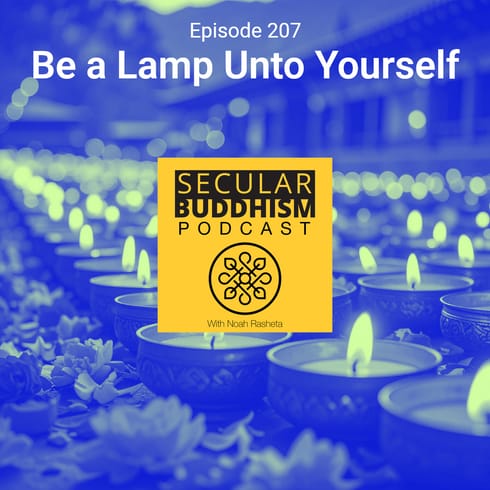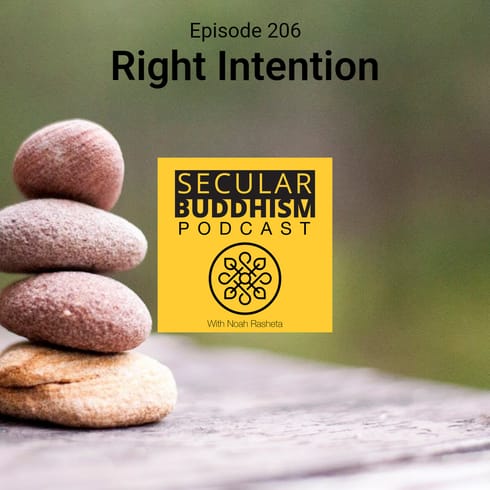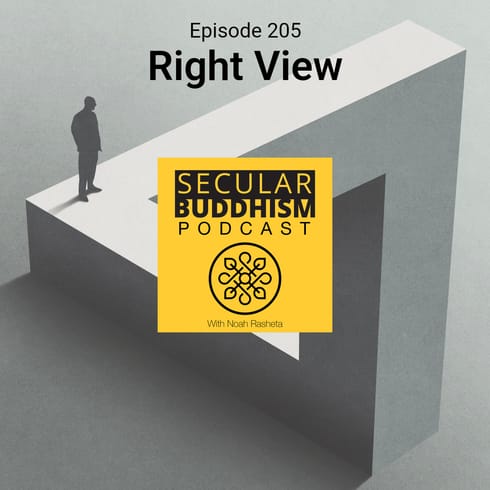
126 - Finding Peace Amidst Chaos
How do we experience more peace in the midst of chaos? In this podcast episode, I will discuss the koan of the waiving mind and also discuss the idea of expanding our perspective to experience more peace amidst the chaos.
Subscribe to the podcast on:
iTunes – https://itunes.apple.com/us/podcast/secular-buddhism/id1071578260
SoundCloud – https://soundcloud.com/secularbuddhism
TuneIn – http://tunein.com/radio/Secular-Buddhism-p823114/
Stitcher – http://www.stitcher.com/s?fid=80132&refid=stpr
Transcript:
Hello, and welcome to another episode of the Secular Buddhism podcast. This is episode number 126. I am your host, Noah Rasheta, and today I’m going to talk about finding peace in the midst of chaos.
As always, keep in mind you don’t need to use what you learn from Buddhism to be a Buddhist. You can use this to learn to be a better whatever you already are.
So let’s jump right into the Zen koan I shared at the end of the last podcast episode. Two monks were arguing about the temple flag waving in the wind. One said, “The flag moves.” The other said, “The wind moves.” They argued back and forth, but could not agree. Hui-neng, the sixth patriarch said, “Gentlemen, it is not the flag that moves, it is not the wind that moves, it is your mind that moves.” The two monks were struck with awe.
I think this koan is very appropriate with the topic of the discussion today, and quite honestly, with the observations that we make on almost any argument that you see on social media or in person. You just picture these two people standing there arguing about whether it’s the wind that moves or it’s the flag that moves, and we see that in almost any conversation. Two completely different perspectives, both trying to get the other one to see the way the other one perceives it, and I shared this on the Patreon group and got some thoughts that I wanted to share from some of the people who are in the group.
The first one comes from Sitae, who says, “Okay, so my initial reaction was to argue with the monks by thinking the flag and the wind both move. Why did I rush to impart my own judgment? Hui-neng reminded me why. My mind moved.” I really like that. I think like Sitae, it’s very common for us to approach this and immediately have our answer and say, like Sitae said, the flag and the wind are both moving, duh. Well, of course that makes sense, because that’s how I perceive it, but that’s the reminder, that right then, what happened? It was my mind that moved. Yeah. I really like that. Thank you, Sitae.
I want to share what Stefan shared in the group as well. He said, “Both monks are seeing the same thing and perceiving it completely differently. Neither is wrong or right. Hui-neng noted that since what they were seeing was the exact same thing, the only difference was in their perception, and therefore their moving mind was the only variable in this situation.” Yes, again, echoing what Sitae said, I think that’s a really neat way to look at this, that the variable, Stefan says, is the moving mind, and man, isn’t that true in almost anything? You can take almost anything …
This is what’s at the heart of the teaching of the six blind men describing the elephant. You have this thing that’s the same thing, and everybody’s perceiving that completely differently, and that’s the situation that we’re faced with. There’s no way for us to be able to make everyone perceive something the same way. It just can’t happen. We all know this, we know this from any news article, any conversation on social media, any anything, and you’re going to have two people come and approach it entirely differently. Sure, sometimes you get someone who views it the same way you do, but we’ve all encountered somebody who sees something very differently from how we view it, and that’s what was taking place here. That’s what this koan is teaching.
So I want to share what David said. David says, “It seems that this koan touches perception and interdependence. There is an external world out there and we can only perceive through our senses and ultimately our mind. So both monks perceive the same objective reality differently, but in the end, it is just the way their mind interprets it, and this is also related to interdependence. The flag and the wind are both needed to generate the experience the monks are observing, and so is the mind that observes the phenomenon.”
I like what David is expressing there with that concept, that of interdependence in this. Without the wind, you don’t have the flag moving. Without the flag moving, you don’t have wind blowing, and, and that’s how all things are. So seeing the interdependent nature of things in this koan is a really cool way to interpret it.
Finally, I want to share Darlene’s thoughts. She says, “What a fascinating koan. My interpretation is that the flag and the wind are concepts which only exist in our minds. We habitually perceive reality filtered through language, our narratives about the world and our nervous systems, and mistake these perceptions for unfiltered reality. Therefore, the movement is a product of our minds.”
Yes, I think that is a common concept that’s found in Buddhist teachings, which is that the external world that we see exists in our minds. In other words, the way I see what’s out there has everything to do with what’s happening in here, and we tend to think that what’s happening in here is happening because of what’s happening out there. Sure, that’s true to a certain degree, but if you’re going to recognize that, you’ve got to recognize the reverse, which that what’s happening out there is interpreted the way we perceive it because of what’s happening in here.
This, to me, points that Alan Watts’ concept of the do happening. I think I’ve mentioned it before. It’s like this constant interplay between the doing and the happening, and things are happening, so that causes the doing, and because things are being done, that causes things to be happening. So everything’s just that balance of the do happening, and that, to me, is what Darlene is kind of explaining here, where the way the mind perceives affects what we perceive, and what we’re perceiving makes the mind perceive it in a certain way, and then they play on each other. It’s constantly happening that way.
Now I want to share some of my thoughts around this same teaching, and then correlate this with the topic of the podcast episode for this week. So the idea of finding peace amidst chaos. I think this is good timing. Like I mentioned in the last podcast episode, the whole world, for the most part, we’re all experiencing a very similar experience right now and this is quite unique, at least in modern times, that we’re all sharing a very similar experience that’s unfolding similarly for people all over the world.
Now, the intensity and the scale is different based on where you are, but it seems like there’s no part of the world now that’s untouched by the coronavirus and the spread of this COVID-19. Earlier this week, I was asked to share some of my thoughts regarding how we can find peace amidst chaos considering that, again, we’re all in this chaotic time, and I wanted to share the audio of my response to that question, because I think that fits in well with the koan and with the concept of the moving mind. So here’s the audio of the response that I shared with regards to the question, how do we find peace in the midst of chaos?
I want to share some thoughts regarding the idea of finding peace in the midst of chaos, in the midst of the situation that we’re going through with this coronavirus, and the thoughts I want to share pertain to the idea of wanting to find peace in the midst of chaos. I think the very fact that we’re looking for peace in the midst of chaos sets us up with a mindset of trying to avoid discomfort, and oftentimes, our discomfort arises because we’re trying to not experience any discomfort, and the truth is that at times, life is uncomfortable, and as we’re all experiencing now, sometimes it’s very uncomfortable, and the fear that arises out of uncertainty is real, the discomfort that arises from the break in our ordinary routine, it’s real, because we’re creatures of habit. We’re social creatures, so when we can’t socialize the way that we’re used to, that creates anxiety, and wanting to not feel that discomfort only aggravates the discomfort.
So the thought I wanted to share around the idea of looking for peace in the midst of chaos would be to perhaps look inward and to reflect on where does that need for peace come from in the first place? Why am I not resilient to the discomforts that arise in life? In other words, can I become more comfortable with discomfort? I think that’s a good place to start with when we’re looking inward, because the truth is we can’t control what’s happening outside of ourselves, and this coronavirus is a perfect example. Causes and conditions gave way for this cascade of domino effect things that started happening that put us, suddenly, right where we are, and we cannot control that.
Now, there are things we can do now to mitigate the potential ramifications of all of this, for example, social distancing, but if we get to the heart of what many of us are after, which is how can I find peace in the midst of all this, I think it’s okay to admit that perhaps we don’t find peace in the midst of it. We always have just a little bit of peace and a little bit of chaos. Things come together and things fall apart, and that’s the nature of life. Things are always switching between that fine line of chaotic and peaceful, and then it’s peaceful and then it’s chaotic and then it’s chaotic and then it’s peaceful, and that’s the nature of things.
So what I like to do in times like this, I think sometimes we have the tendency to want to try to think positively or try to push away the fears and the anxiety or the uncertainty, and try to force ourselves to not dwell on the difficulties that we’re experiencing, and I don’t think that’s helpful. I think rather than pushing away the discomfort, we allow the discomfort to be there. We welcome it with open arms, we acknowledge that, “Yes, things are scary. I don’t know where all of this ends. I’ve never dealt with a situation like this and that’s scary,” but we can also, at that moment, open up our awareness to everything else that’s going on by simply asking ourselves, “What am I not noticing?” A very simple thing that I may notice that I’m not noticing is that, for example, I don’t have a toothache right now, or right now I have a roof over my head, and right now it’s not raining on me while I’m outside without a roof.
There are many things that we can bring into our sphere of awareness without negating the difficulties that we’re also experiencing in our sphere of awareness, so we can say, “Yes, while I am anxious and nervous and understandably fearful of how things are, I’m also noticing that I don’t have a toothache, that I have my health for now, that I have a roof over my head or that I’m still spending time with the people that I love, I still have them.”
What we do when we start doing that is we’re increasing our awareness. That’s kind of what mindfulness practice is. It’s asking ourselves, “What am I not noticing?,” and by paying attention to the things that we’re not noticing, we’ll notice that there are a lot of things that are happening and arising simultaneously with the discomfort, with the fear, with the anxiety. There are also feelings of joy, of gratitude, of safety, and these things can exist simultaneously with the others, and I think sometimes we get caught up in this thinking that it’s one or the other. If I have peace, then I don’t have chaos, and the truth is we can have peace in the midst of chaos, we can have bravery in the midst of fear, we can have doubts of uncertainty in the midst of gratitude of some things that feel certain. These things are not mutually exclusive.
That ultimately is how we start to find peace in the midst of the chaos that we’re experiencing. That’s also how we handle the anxiety that we may be feeling in the midst of all this. We don’t handle the anxiety by trying to get the anxiety to go away. We handle it by recognizing it’s okay to feel anxious. There’s a reason why we’re feeling anxious, but what else? What am I not noticing? In that analysis, we may notice other things that minimize the anxiety, because suddenly it gives way for something like gratitude or something like contentment or joy. So increasing our sphere of awareness is a powerful form of practicing right now during these difficult times to see more, to not allow ourselves to zero in on the one thing that’s giving us so much fear or anxiety.
Just open up your perspective and see more what am I not seeing? In that analysis, we’re not pretending like this scary stuff isn’t here, we’re allowing that to stay there, but we’re trying to see more. That’s what I would recommend as a practice during this time, and hopefully by asking yourself, “What am I not noticing?”, you’ll start to notice things that you hadn’t noticed before that may be there in the midst of the scary, and don’t try to push the scary away. This is new for all of us. Everything that we’re going through right now is new for all of us. So give yourself a little bit of patience and allow yourself to embrace all the emotions that arise, all the fears, but then open up your eyes to see more and allow more of it in. If there’s anxiety, that’s fine, but there’s also gratitude. Look for that. What are you grateful for? In the midst of that, we increase our awareness.
So good luck to all of you with everything that you’re going through, and I hope you can use this time to learn a little bit more about yourself and to see things that you hadn’t noticed before. Thank you.
That’s all I have for this podcast episode. Thank you for listening. If you want to support the work I’m doing with the podcast, consider becoming a patron and joining our online community where we discussed the koans, podcast episodes and more. You can learn more about the online community by visiting secularbuddhism.com. If you enjoyed this podcast episode, please share it with others, write a review, give it a rating in iTunes. That’s all I have for now, but I look forward to recording another podcast episode soon. Before I go, here’s the Zen koan to work with this week. When you can do nothing, what can you do?



